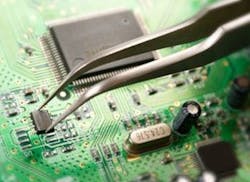Alfa conductive epoxy passes NASA outgassing tests, wins approval for aerospace, electronic uses
WOONSOCKET, R.I. A two-part, pure silver-filled electrically conductive epoxy, known as E10-101, from Alfa International Corp. in Woonsocket, R.I., has passed NASA’s ASTM E-595 outgassing tests, ensuring it meets the Total Mass Loss and Collected Volatile Condensable Materials from Outgassing in a Vacuum Environment specification.
E10-101 is designed for electronic bonding and sealing applications that require both fine electrical and mechanical properties. Following successful testing, it is now listed in NASA’s database as an approved product for aerospace and electronic uses and for selecting spacecraft materials.
E10-101 bonds strongly between various substrates, including aluminum, copper, magnesium, steel, bronze, nickel, kovar, ceramic, glass, phenolic, and G-10 epoxy glass boards. This versatile silver formulation offers the maximum continuity of conductivity with an electrical resistivity value of less than 1x10-4 ohm·cm and is characterized by a wide operating temperature range from –50 to +170°C, officials say.
E10-101 can be used in diversified applications as microwave, electromagnetic interference (EMI), and radio-frequency interference (RFI) shielding, in the assembly or repair of printed circuit boards, wave guides, electronic modules, flat cable, high-frequency shields, connections, and circuitry and as a cold solder for high-sensitive components where hot-soldering is impractical.
E10-101 is widely used in demanding electronic, electrical, computer, and semiconductor applications, and across the aerospace community. Conductive adhesives, such as E10-101, are a fit for electronic packaging applications, such as die attachments, solderless interconnections and more.
Its unique formulation offers ease in handling due to its creamy consistency and versatility in methods of application, officials say. It can be applied by hand, automatic dispensers, silk-screening, transfer, or stamping techniques.
E10-101 is currently used “for conductivity from a part casing to ground” as well as “adhering a touchscreen display to a metal bracket during assembly.” Company officials say E10-101 has been used in high-tech applications for more than 20 years. A nickel-filled version is also available.

